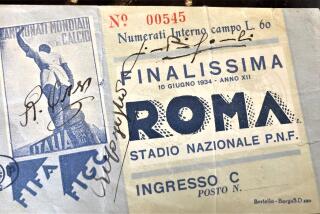Coin Collectors Thrown for Loss : Soccer: World Cup organizers netted $9 million from sales of commemorative coins, but U.S. Mint lost $5 million.
- Share via
Even the most hopeful sports fans were long ago disabused of the notion that politics and sport don’t mix. Olympic boycotts and demonstrations to serve political ends have illustrated clearly that--as is the case in most other aspects of our lives--the business of politics permeates.
Now, a new wrinkle in the marriage of politics and sports: commemorative coins.
The politically connected honchos of the World Cup Organizing Committee got Rep. Esteban E. Torres (D-Calif.), former chairman of the House Subcommittee on Consumer Affairs and Coinage, to sponsor legislation directing the U.S. Mint to produce World Cup commemorative coins, with the organizing committee to benefit from a surcharge added to the cost of each coin.
The plan ended up as a financial windfall for the World Cup, which netted nearly $9 million from the program. But it wasn’t such a good deal for the mint. The World Cup commemorative coin program became the first in modern times to lose money, more than $5 million, according to a report prepared by the mint.
The World Cup commemorative coin bill, authorized by Congress and signed by President Bush in 1992, called for the striking of 10.75 million coins of varying face value, all of which are legal tender. Commemorative coins sell for considerably more than face value. The soccer coins were a flop. Fewer than 1 1/2 million were sold.
The spectacular failure of the World Cup coin program may bring an end to a practice that coin collectors and Washington insiders say is a decades-old way of using public money to fund pet projects.
“What it is, is a way for people in Congress to get around the appropriations structure to award money to a favorite program or person,” said Christopher Batio, a writer with Numismatic News, a national collector’s weekly. “They (the mint) are trying to rein it in. But it’s a slow process. You can’t say to congressmen that they can’t have their perks. They want them.”
Torres, who sponsored the World Cup coin bill, acknowledged that the commemorative program was “like a runaway train.”
“Everyone (congressmen) wants to get into the commemorative coin business for obvious reasons,” Torres said. “It’s not so much that members want to provide perks. But they are besieged by interest groups--everyone comes at you. They make a hard sell that their group is worthy of a coin.”
In the case of the World Cup coins, the mint’s loss was the organizing committee’s gain. The commemorative coin program has added, so far, $8.8 million to World Cup’s revenues.
It’s easy to see why commemorative coins are popular as a political give-back. The designated patron takes no risk and is guaranteed a profit.
The mint (read: taxpayers) pays for the design, manufacture, marketing and distribution of the coins and takes all the financial risks.
And the mint (read: taxpayers) will now have to cover the program’s $5.5-million loss.
Meanwhile, the World Cup, which recently announced it had made a $60-million profit on last summer’s event, has already happily endorsed the federal checks.
Years of political wheeling and dealing have left some coin collectors with a jaded view of the mint’s commemorative program as little more than a conduit to funnel public money to politically expedient sources. It’s called pork-barrel legislation.
Mike White, a spokesman for the U.S. Mint, pointedly responded to the question of pork with a time-honored answer in Washington: It’s Congress’ fault.
“We have testified (before Congress) consistently for fewer coins and lower mintage limits,” he said from his office in Washington. “We strike the coins they tell us to. At the end of this last session, for example, there were five commemorative-coin bills attached to the Interstate Banking bill alone.”
By most measurements, the commemorative program has been glutting the market and the situation is getting worse. More commemorative bills have been passed by Congress in the last year than in the preceding six.
Collectors lose on the mint’s overproduction because market values drop. The World Cup debacle has prompted many collectors to refuse to accept more commemorative wooden nickels.
Consumers may or may not consider commemorative surcharges as added costs--indeed, many may not realize they are paying a surcharge--but in the case of the World Cup coins, the surcharge represented as much as 25% of the coin’s total retail cost. For example, a uncirculated World Cup commemorative silver dollar sold for $28. Included in the purchase price was the surcharge payment of $7, which went to to the World Cup Organizing Committee.
Even if Congress could be counted on to control its largess in the future, it will be too late to stop a commemorative coin program set to launch in January: 1996 Olympic coins. The bill calls for the minting of 18 million coins of 32 types.







